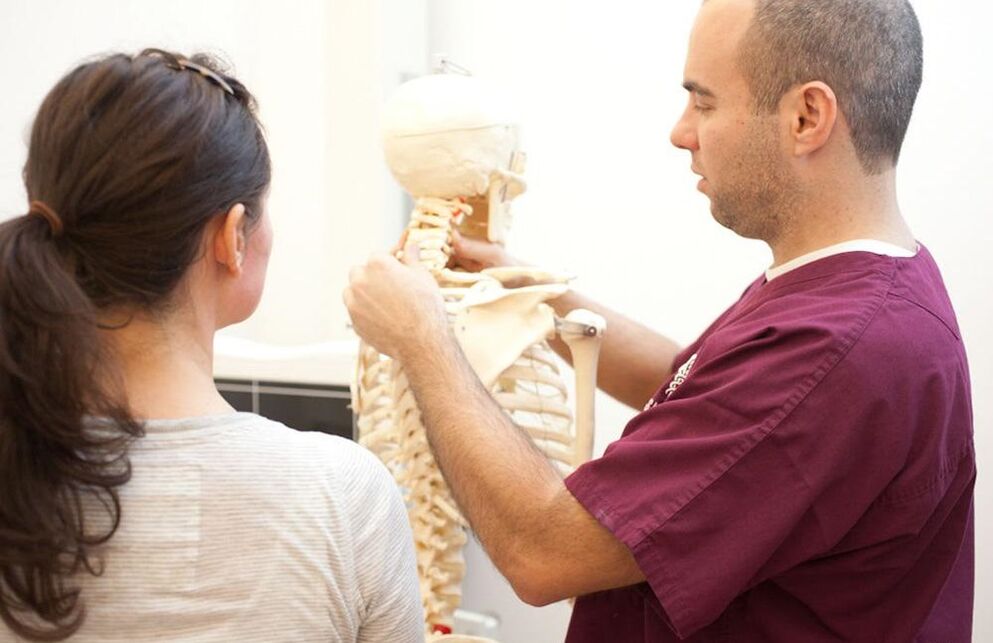
In this article, we will consider the symptoms and treatment of cervical osteochondrosis. What pathology is this? How does it show up?
Osteochondrosis is actually the most common disease in the world. Many people after the age of 30 suffer from this disease in various forms. There is also a tendency to rejuvenate the disease, which is to lower the age threshold. This may be because more and more people are mainly engaged in work, and a person sits there most of the time and leads a sedentary lifestyle. By the way, this disease is dangerous, everyone must know what cervical osteochondrosis is, how it appears, how to treat it and how to be able to recognize its symptoms.

Main cause of illness
A person’s design is that the vertical placement of the spine will cause the vertebrae to be more and more compressed over time, resulting in the gradual degradation and deformation of bone and cartilage tissue.
The spine always starts in the area of the cervical spine with seven vertebrae. This is one of the particularly vulnerable parts because of the increased mobility in the area. Such cervical spondylosis is first manifested in the intervertebral disc itself, because they are weak points of the spine.
The incidence of degenerative disc disease in the cervical and thoracic region is affected by factors such as small vertebrae size and relatively weak neck muscles. In addition, insufficient blood supply to cartilage tissue can affect developing diseases. What does it mean?
From this point of view, the development of this disease seems to be a long and complicated process, and the cause is very difficult to distinguish. Although it has been found that there is a link between a sedentary lifestyle and cervical thoracic spine osteochondrosis, similar diseases often occur in trained people, especially athletes, because of their increased load on the cervical spine. They lift various weights (barbells, heavy objects), which can cause deformation of the intervertebral discs. So everything needs to be measured.

In the elderly and the elderly, this degradation of vertebral structure is usually an inevitable process, which in turn is related to the body's aging and weakening of defense capabilities. But there may also be pathological types of cervical osteochondrosis, the symptoms of which are due to internal or external negative factors. These include:
- Various back injuries;
- Clostridium;
- Heavy
- Improper posture
- Decreased physical strength;
- Arduous physical labor;
- Disorders of metabolic processes;
- Low temperature;
- Overworked and stressed;
- Infectious diseases;
- Genetic
- Congenital diseases or special characteristics of body structure.
Stages of cervical osteochondrosis
There are four stages of pathology. According to general analysis, it is sometimes difficult to determine which stage of the disease the patient is in, because in most cases the level of bone tissue degradation may be inconsistent with the symptoms observed by the patient.
The first stage of the disease
At this stage, destructive behavior has occurred in the vertebrae. However, the symptoms of cervical osteochondrosis are not very obvious. People may not notice them or associate these signs with spinal diseases, which they call stress or mediocre overwork.
The second stage of the disease
As mentioned earlier, the symptoms of cervical osteochondrosis are closely related to treatment.
At this stage, the magnetic disk is significantly thinner and cracks appear on its surface. At this stage, the symptoms of cervical osteochondrosis were observed to be persistent pain, facial numbness, and weakness.

The third stage
At this stage, how are the symptoms of cervical osteochondrosis manifested? A herniated intervertebral disc occurred, and the blood vessels and muscles of the neck were affected. The person noticed dizziness and pain in the back of his head.
The fourth stage of the disease
For cervical osteochondrosis, osteophytes often occur-the bone tissue that protects the vertebrae from pressure proliferates, thus causing nerve compression. It is characterized by stiffness in movement and damage to adjacent joints.
Signs of cervical osteochondrosis
The main symptoms of cervical osteochondrosis are:
- Severe pain in the shoulder and neck.
- Muscles are weakened.
- Increased sweating.
- Impaired coordination.
- Numb hands.
- Dizziness.
- hypertension.
- Hearing and vision loss.
- Headache.
These common symptoms of cervical osteochondrosis can be manifested at all stages of the disease. In most cases, only a few signs in this list are visible, and the remaining signs may not exist at all. The patient who encountered them for the first time was not actually diagnosed with cervical osteochondrosis. In this case, he can turn to different doctors-cardiologists, neuropathologists, therapists, surgeons. And finally a reliable diagnosis can be confirmed with a significant delay.
Pathological risk
Not everyone knows the symptoms and treatments of cervical osteochondrosis.
The earliest symptoms of osteochondrosis can appear as early as about 20 years, and the pain and discomfort are relatively mild, so many people decide to wait, hoping that the symptoms will pass, postpone treatment, and not start treatment. The early symptoms of osteochondrosis can indeed go away on its own, but the disease will not go away from a person. Without prevention and treatment, osteochondrosis begins to develop further, which may be dangerous to human health.

What are the hazards of cervical osteochondrosis?
In the first stage, the symptoms are mild, so most people are unwilling to take this disease seriously. However, if the patient does not start treatment in the early stages of development, it can lead to dangerous and serious complications. The consequence of a neglected stage is a situation where a person cannot perform his duties. This can usually be accompanied by lesions in adjacent departments. This abandoned osteochondrosis can lead to very dangerous consequences, which in turn leads to disability.
In addition, it may develop:
- Herniated disc;
- Herniation and intervertebral hernia;
- CD is missing;
- Low back pain or sciatica;
- Spinal process of the spinal canal.
Under special circumstances, the above-mentioned diseases are forced to undergo surgical intervention, and the late consequence is disability.
The problems listed above are characteristic of cervical and thoracic spine osteochondrosis.
Complications of the disease
The danger of this disease is that the neck area is connected to the blood vessels that supply the brain. The consequences of cervical osteochondrosis are sleep disorders, migraines, vision problems, and dizziness. For advanced diseases, the symptoms listed will become more pronounced. For cervical osteochondrosis, the following problems may occur:

- Hypertension or hypotension and vascular dystonia;
- Thyroid disease;
- Vestibular disorders;
- High blood pressure or low blood pressure;
- Stroke;
- Epicondylitis;
- Diseases around the humeral joints.
Pathological diagnosis of cervical spondylosis
Many people are interested in the symptoms and treatment of cervical osteochondrosis.
In order to make a correct diagnosis, you must consult a therapist. He will refer him to other specialists-neurologists, chiropractors, orthopedists.
In order to diagnose the disease, the following types of studies are attached:
- CT scan;
- Radiography
- Nuclear magnetic resonance
- Doppler scan.
X-rays show growth, vertebral displacement, salt deposits and the presence of osteophytes and disc seals. With the help of computed tomography, you can learn quite a bit about the organ (in this case, the cervical spine). It will allow a detailed description of the stages of the pathological process, as well as the nature of the nerve clamp, the height of the intervertebral disc and the structure of the osteophytes. Magnetic resonance imaging provides a more detailed picture of the structure of the spine. Ultrasound scans can help determine how the blood flow in the large blood vessels in the neck changes, which is caused by the disease.

Treatment of this disease
The symptoms and treatment of cervical osteochondrosis are interrelated.
In order to enable people to resist diseases, medicine has developed many methods. You can also use some therapies at home. But this process is very long, and complete recovery is impossible, especially in old age. But it is also worth noting that at any stage of the disease, it is possible to prevent and slow down the pathological process of the spine.
In the early stages of the disease, the treatment of cervical osteochondrosis is mostly conservative. Several methods can be used for treatment:
- physiotherapy;
- drug;
- massage;
- physiotherapy;
- A special device used to fix the spine.
If this disease has advanced to an extreme stage and the osteochondral structure of the spine is destroyed, then surgical intervention should be used to cure the osteochondrosis of the neck.
Pathological treatment drugs
Necessary drugs for the treatment of cervical osteochondrosis:
- Analgesic
- Vitamin
- Chondroprotective agent;
- Anti-inflammatory drugs;
- Antispasmodic.
When an acute pain syndrome associated with osteochondrosis occurs, the most important task is to remove it. In this case, oral pain relievers can be taken, but if their effect is not obvious, novocaine blockers can be used.
The symptoms and treatment of cervical osteochondrosis are often controversial for many people.
Take antispasmodics often. Muscle relaxants show the greatest effect in osteochondrosis. As analgesics and anti-inflammatory drugs, patients can use ointments containing non-steroidal drugs.
If there are signs related to impaired blood supply to the brain and vertebral artery syndrome, it is necessary to use drugs to eliminate its unpleasant manifestations-blood pressure lowering drugs and nootropic drugs.
The symptoms and treatment of cervical osteochondrosis are no longer a secret.

Physical therapy exercises
Physical therapy is the simplest and most accessible type of treatment and prevention of cervical osteochondrosis, and it is also quite effective. Physical therapy can also be done at home. For cervical osteochondrosis, the saturation of the class does not have much effect, only their regularity is needed. First of all, physical education is designed to strengthen the neck muscles. Its task is to make up for the lack of spinal function and help support weak vertebrae. The treatment of cervical osteochondrosis should be carried out regularly.
Daily exercise is necessary to strengthen muscles. This type of exercise may be very simple, including turning and tilting the head in different directions, or it may be very complicated, requiring hands to help the cervical spine muscles. They can be done at home and at work. For example, if you have to sit and work all the time, sitting in front of a table and monitor every hour for various exercises is very useful. But this is only necessary if the disease has not worsened and there is no pain syndrome. Otherwise, these same exercises will only worsen the condition.
It can also effectively treat cervical osteochondrosis to strengthen the shoulder girdle muscles, for example, using light dumbbells during regular exercise. However, lifting weights such as kettlebells or barbells is contraindicated. Regular swimming activities may be helpful because it reduces the pressure on the spine.
We checked the symptoms and treatment of cervical osteochondrosis.














































